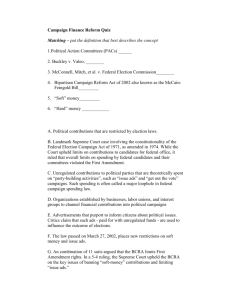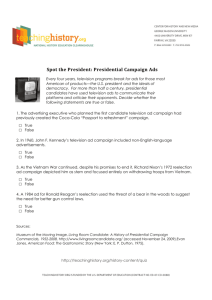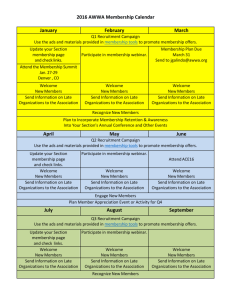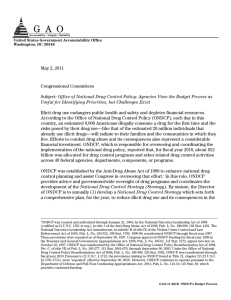The Effectiveness of Mass Media Campaigns: Youth Substance Abuse
advertisement
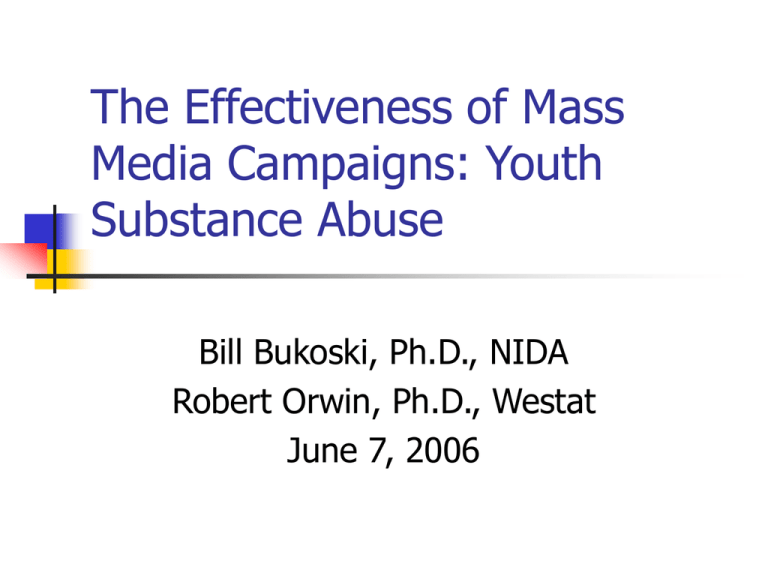
The Effectiveness of Mass Media Campaigns: Youth Substance Abuse Bill Bukoski, Ph.D., NIDA Robert Orwin, Ph.D., Westat June 7, 2006 OVERVIEW 1. 2. 3. 4. Youth’s Exposure to Mass Media. Possible Risks of Mass Media. Possible Benefits of Mass Media. Findings From Westat’s Evaluation of ONDCP’s Anti-drug Abuse Campaign for Youth and Parents. 1. Mass Media is Pervasive in the Lives of Youth (Kaiser Report, 2005) TV, radio, music, magazines, movies, video games, cell, internet, e-mail, IM, cds, dvds, MP3, etc. Youth (8-18) – 6.5 hrs per day or 44.5 hrs per week – all forms of media. 30% multi-task: phone+IM+music++ TV+surf the web. 53% - families have no rules - TV. 51% - use web daily. 32% - use IM daily 2.25 hrs - parents; 1.5 hrs exercise; 50 min – homework. 2. Risks of Mass Media - Youth Research – an overwhelming presence of alcohol, tobacco, illicit drugs in mass media viewed by youth (Thompson, 2005). Mass media portrays unhealthy behaviors as glamorous and risk-free (Brown and Witherspoon, 2002). Mass media poses a significant public health risk for youth (Am. Acad. Ped., 1995; 1996; 1999; 2001a; 2001b; 2001c.) Examples of Risk: Alcohol From 2001-2004, the ave. number of TV alcohol ads seen by youth increased 32% 209 to 276 (CAMY, 2006). The top 15 TV shows with the largest youth (12-17) audience had alc. ads (CAMY, 2005). Nat’l long. survey (15-26): on ave. more al. ads (TV, radio, mags, billboards)- more drinking. Each ad seen increased num. of drinks consumed in past month by 1% ; holds also for greater al ad expenditures by market area (Snyder et al., 2006). Examples of Risk: Alcohol Ellickson et al. (2005) studied exposure effects of al ads (TV, mags, in-store displays, beer concessions) on drinking initiation and drinking freq. for 7-8-9th graders. Multivariate analyes - increased exposure to al. ads in 8th grade for 1) 7th grade nondrinkers - predicted al initiation by 9th grade; 2) 7th grade drinkers- predicted increased drinking freq. by the 9th grade. Examples of Risk: Smoking In a nationally representative random digit phone survey of 10-14 year olds, Sargent et al. (2006) found a positive association between increased exposure to smoking in movies (N=524 hits) and smoking initiation. In comparison to the lowest Quartile of smoking in movies (Q1), Adjusted OR for having tried smoking was 1.7 for Q2; 1.8 for Q3; and 2.6 for Q4. Attributable Risk = 38%. Exposure was primary risk of smoking initiation for 38% who tried smoking. Examples of Risk: Drug Use A recent study of more than 1200 films rated G, PG, PG-13, and R, and released between 1996 and 2003 reported that 95% of films depicted substances (drugs, alcohol, tobacco) while the Motion Picture Association referenced drugs and alcohol in only 18% of its ratings (Thompson, 2005). NIDA’s PRISM award promotes accurate depictions of drug, alcohol, tobacco use in film, TV, video, music, and comic books (NIDA Press Release, 2006). “Just a Click Away”: Drug Use Web Sites Wax (2002) indicates that the internet provides free, unedited, and nonrefereed information about “recreational” drug-taking behavior. While anti-drug web sites exist, the web sites that espouse “risk reduction, safe and responsible” drug use are easily accessible by children. Internet Drug Sales Forman (2006) reports that the Internet conducts drug business transactions 24 hours a day, across the globe with relative anonymity. The sale of prohibited Schedule I drugs (marijuana, heroin, crack cocaine) and Schedule II-V drugs (sedatives, analgesics, stimulants, steroids, etc.) can be obtained online from “no-prescription” web sites by anyone with access to a credit card to include youth. 3. Benefits of Mass Media Promotes messages that value rather than devalue youth (Klein et al., 1993). Help youth make better decisions about health risks they face (Klein et al., 1993). Multiple components: TV-radio ads, web, videos, print, school/comm./parents, policy. Mass media “campaigns” have been studied for over 5 decades (Wartella et al., 1991). Meta-analysis indicate effect sizes are small and can be negative or positive (Snyder et al., 2004). Theories for Mass Media(NCI, 2005) Behavior is mediated by cognitions – what people know and think drives actions. Knowledge is necessary but not sufficient for behavior change. Beliefs, Attitudes, Intentions, Perceptions, Motivation, Skills, Social Environment, Ad Exposure and Message Saliency influences behavior change. Theories (cont.) Theory of Reasoned Action Theory of Planned Behavior Social Innoculation Theory (Fishbein & Ajzen, 1975). Beliefs, Attitudes, Intentions, Behavior. (Akzen, 1991). In addition --- Intentions are influenced by perceived behavioral control. (McGuire,1964). Small doses of pro-ads are analyzed to promote negative responses. Theories (cont.) Psychological Reactance Social Marketing (Brehm & Brehm, 1981). If freedom to engage or not engage in a behavior is threatened or denied, motivational arousal is prompted to restore lost freedom. (Zimmerman, 1997). Ads that appeal to the target audience’s norms, attitudes, motivations – does not try to change them. A focus on changing the social environment as well. Incorporates commercial marketing principles of product, price, place, and promotion. Theories (cont.) Sensation Seeking Targeting-SENTAR (Palmgreen & Donohew, 2003). Focus is on “sensation seeking” – a personality trait that represents a need for novel, complex, ambiguous, and emotionally intense stimuli; associated with drug use. Media campaigns target high sensation seeking youth, include messages that are fast paced and elicit arousal, and match viewing habits of high sensation seekers. Observation: Media Health Communication Effects In 2003, 83.6% of youths 12-17 (20.8M) reported exposure in past year to an alcohol or drug message: poster, pamphlet, radio, TV, etc. (NSDUH Report, 2005). BUT… research findings on behavior are mixed. Mendelson (1968) described “mass communication as a sort of an aerosol spray. As you spray it on the surface, some of it hits the target; most of it drifts away; and very little of it penetrates.” Meta-Analysis of Media Health Campaigns on Behavior Mediated health campaigns in the U.S. have small effect sizes in the short-term. ES = average correlations (Synder et al., 2004). ES = .15 - seat belts ES = .13 - oral health ES = .09 - alcohol ES = .05 - heart disease prevention ES = .05 - smoking ES = .04 - sexual behaviors Meta-Analysis of Substance Abuse Campaigns (Derzon et al.,2002) Substance Use ES = .036 (pre-post) Knowledge ES = .049 (pre-post) Attitudes ES = .024 (pre-post) Mass Media Effects on Substance Using Behaviors M e d i a F e a t u r e ( N w i t h ,N w i t h o u t ) E x p o s e d t o M e d i a I n t e r v e n t i o n ( 4 8 ,1 8 ) * S o u r c e R a d i o ( 2 4 ,2 4 ) * V i d e o ( 1 2 ,3 4 ) * T e l e v i s i o n ( 3 2 ,1 5 ) * P r i n t( 3 6 ,1 2 ) * M e s s a g e T a r g e t P a r e n t s a n d S i g n i f i c a n tA d u l t s ( 1 8 ,2 4 ) * R e t a i l e r s a n d O t h e r s ( 2 7 ,2 1 ) * Y o u t h ( 3 1 ,9 ) * M e s s a g e C h a r a c t e r i s t i c s I n f l u e n c i n g O t h e r s ( 1 3 ,1 4 ) * A l t e r n a t i v e s t o U s e ( 1 1 ,1 2 ) * P o s i t i v e A t t i t u d e s t o N o n U s e ( 2 4 ,6 ) * K n o w l e d g e o fC o n s e q u e n c e s ( A l l ) * N e g a t i v e A t t i t u d e s t o U s e ( 4 1 ,3 ) * P e r c e i v e d N o r m a t i v e U s e ( 2 9 ,2 ) * R e s i s t a n c e S k i l l s ( 1 5 ,9 ) * S u b s t a n c e A d d r e s s e d A l c o h o l( 3 6 ,1 1 ) * I l l c i tD r u g s ( 3 7 ,1 1 ) * M a r i j u a n a ( 3 9 ,6 ) T o b a c c o ( 1 2 ,3 5 ) * A n y ( 4 0 ,6 ) * I n t e r v e n t i o n C h a r a c t e r i s t i c s S e r i e s o r S e q u e n c e d M e s s a g e s ( 4 ,3 6 ) * O n e T i m e M e s s a g e O n l y ( 1 ,4 6 ) S u p p l e m e n t a t i o n ( 2 1 ,2 5 ) * R e p e t i t i o n ( 3 3 ,7 ) G e n e r a lB r o a d c a s t( 3 3 ,1 5 ) * M u l t i p l e ,D i f f e r e n tM e s s a g e s ( 4 4 ,4 ) * A r r a n g e d A u d i e n c e ( 1 9 ,2 8 ) * R e c i p i e n t C h a r a c t e r i s t i c s S u b j e c t s A t R i s k ( 1 0 ,3 3 ) U n d e r 5 0 % M a l e ( 1 5 ,2 8 ) * U n d e r 2 2 Y e a r s ( 2 2 ,2 4 ) * G a i n w i t h c h a r a c t e r i s t i c G a i n w i t h o u tc h a r a c t e r i s t i c * p < . 0 5 0 . 1 0 0 . 0 5 0 . 0 0 0 . 0 5 0 . 1 0 0 . 1 5 M e a n P r e P o s t S t a n d a r d i z e d G a i n E f f e c t S i z e s 0 . 2 0 Summary of Mass Media Benefits (Crano, 2002) “…the results do not suggest that the mass media represents the magic bullet…which will end drug-abuse in adolescents…” “…most media researchers today recognize that the media alone are not likely to turn the tide of drug abuse…” “…mass media are better viewed as part of an arsenal of weapons that may be directed at the problem.” Recent Promising Findings The National Legacy Foundation launched a national “truth” anti-smoking campaign for youth – 2000 to 2002. Costs: $100 M per year with paid media ads. Based upon effective “truth campaigns” in Fl, Calif, Mass., etc. Truth ads were hard hitting to reveal deceptive marketing by tobacco industry, e.g. promoted only glamour of use; ignored: multiple causes of death; nicotine addiction, targeting teens to replace dying adults. Truth Campaign (cont.) Hersey et al. (2005) reports on a national random digit dial phone survey of 16,000 youths 12-17 (before, 8 months and 15 months after launch) that youths in television markets with higher campaign exposure by comparison had: Significantly more negative beliefs and attitudes about tobacco industry; lower intentions to use, and lower receptivity to pro-tobacco ads and marketing practices, e.g. brand merchandise, etc. Truth Campaign (cont.) Farrelly et al., 2005 reports a dose-response relationship between exposure to truth ads and youth smoking prevalence. The study compared Gross Rating Points (GRPs) for the truth campaign in each of 210 U.S. television markets for schools in those markets that were involved in MTF 1997-2002 (MTF controls –1997-1999). Truth Campaign (cont.) Farrelly et al., (2005) reports that: Smoking prevalence for youth in grades 8, 10, 12, declined on average from 25.3% (1999) to 18%(2002) with the largest decline occurring for 8th graders. Exposure to the “truth campaign” accounted for 22% of this decrease in smoking prevalence. The decline in prevalence as of 2002 was equivalent to having 300,000 fewer youth smokers as a result of the truth campaign. Recent Promising Findings: InSchool Media + Community In a national RCT, Slater et al. (2006) tested in middle schools a media program (print, posters, T-shirts, book covers, water bottles) with the positive theme of “Be Under Your Own Influence” in combination with related community activities. Findings: Dramatic and significant drug reductions were reported for treatment vs. comparison students. OR – Marijuana .50; Tob. .49; Alcohol .40 Mass Media+School Programs In a RCT (1997-2002) with 45 high schools and feeder schools, Longshore et al. (2006) tested the effects (on 9th graders) of ONDCP’s Anti-Drug Campaign in combination with a drug prevention program - ALERT Plus (in 7th and 8th + boosters 9th and 10th). Findings: 1) Sign. lower monthly marijuana for ALERT Plus “and” weekly exposure to ONDCP’s media campaign - synergistic effect; 2) No comparable main effects for ALERT PLUS or ONDCP’s media campaign. Mass Media and High Sensation-Seeking Youth Palmgreen et al. (2005) reports on an “interrupted” time-series analysis of exposure to ONDCP’s media campaign (Marijuana Initiative) in two counties in Kentucky (Oct. 2002 –June 2003) that compared High Sensation-Seeking (HSS) vs. Low SensationSeeking youth (LSS). Findings: 1) Sign. reductions in 30 day marijuana use for HSS teens; 2) Sign. increase in perceived negative consequences of marijuana (HSS); 3) No campaign effects for LSS. 30-day Marijuana Use Regression Plots for HSS and LSS Youth Mass Media for Youth + Parents (NSDUH Report, 2005) In 2003, 14.6 M youth 12-17 (58.9%) talked with parents over the past year about the dangers of tobacco, alcohol, or drug use. Youth who talked with parents were sign. less likely to report past month alcohol use, binge drinking, and illicit drug use. Youth who reported seeing anti-drug media messages over the past year were sign. less likely to report past month binge drinking and illicit drug use. Dual Mass Media – Youth and Parents: ONDCP’s Campaign Major Goals: 1) enable youth to reject illegal drugs; 2) prevent initiation of marijuana; 3) promote drug cessation for occasional users. 1998–2005, campaign costs = $1.325 Billion. Dual Media Campaigns: 1) Youth (9 to 18); 2) Parents/Caregivers --- Westat’s evaluation of Phase 3 of campaign - September 1999. Campaign: paid ads on TV+PSAs, radio, ads in magazines and newspapers, billboards, movie spots, video rentals; web site; press. Partnership for a Drug-Free America--- media


